About Us
The Mapping Militants Project
The Mapping Militants Project (MMP) traces the evolution of violent militant or extremist organizations in specified conflict theatres and analyzes their interactions.
This visualization illustrates the networks that militant groups develop both within and across conflicts. Users can explore the network by dragging and dropping nodes and zooming in and out. For readability, only the largest nodes are initially labeled with group names. As the user zooms in, more group name labels appear. To override this setting and see all group labels, users can toggle “Show All Labels” on the righthand tool bar.
Each node represents one militant organization in the MMP database. The size of the node captures the number of connections – more connected groups have larger nodes. Hover the mouse over a group node to highlight all its connections. Click on a group’s node to learn more about the group and the extent of its ties. Filter the network by using the righthand toolbar to narrow results by type of connection, group name, or “map” name. Each filter includes a textbox where users can type to search for specific connection, group, or map names.
Users can also utilize the year filter to explore how the militant network changes over time. Mapping Militants codes the start date of each connection, and connections are treated as ongoing until a different type of connection is formed between two groups or one of the two groups becomes inactive. The year filter allows users to filter to a specific year to observe which connections were ongoing in that year. Users can also view connections active within a range of years.
The data used for this visualization are coded from MMP’s militant group profiles, which rely on in-depth qualitative research conducted by undergraduate and graduate research assistants. Users can view and filter the data behind this visualization by going to the data tab. Read more about MMP’s research methods https://mappingmilitants.org/frequently-asked-questions.
This visualization was created with the support of the Center for Research Computing (CRC) at Rice University. MMP received funding from the National Counterterrorism, Innovation, Technology, and Education Center (NCITE), a U.S. Department of Homeland Security Center of Excellence based at the University of Nebraska, Omaha (Grant Award Number 20STTPC00001-03).
